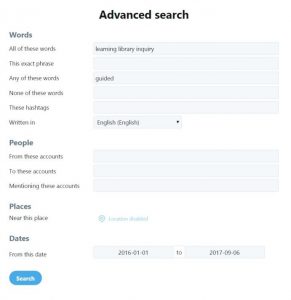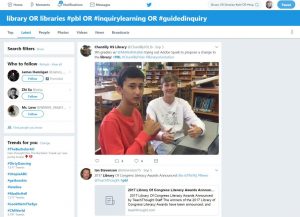Twitter is an excellent tool to use to learn from, share with and develop professional learning networks. I have learned a lot from teacher-librarians and educators near and far through the affordances of Twitter. I have never really tried to use Twitter as a research tool (and I assume it is not really designed to do so) however, I have seen (and retweeted!) many articles and ideas that have helped my in my professional practice as a Teacher-librarian, so I know there are some gems to be found! I focused on the library context for this search as my inquiry question about how inquiry can be implemented in a library context is less focused on scholarly research and more on putting theory into practice.
This phase of my ISP is a combination of Formulation and Collection (Kuhlthau, 2004b). My thoughts are focused and I have an increased interest, as well as a sense of direction.
At this stage in my inquiry circuitry, I feel as though I have a highly conductive material, allowing the electrons to travel quickly to illuminate the lightbulb.
With my renewed goal of finding practical information that can applied to my worklplace, I have rephrased my second question. Formerly it was: Q2. How can Inquiry Learning be implemented meaningfully in a library context? It has become: Q 2.2. What does inquiry learning in a primary school library ‘look’ like?

Twitter has a search bar in the top right where you can enter search terms much like Google. However, it is much simpler, with many of the usual shortcuts not functional in Twitter. To make things a little clearer, you are able to do an Advanced Search, which, much like Google and A+ Education, gives you rows to refine your search parameters.
As expected, my search for library “guided inquiry” did not result in scholarly research articles, (like you would expect to find using Google Scholar or a Library database), however, it brought up information that may become useful as I continue my inquiry. For example, references to experts in the field and professional development in the field of inquiry learning helped identify potential sources for future learning. For example, Lesley Maniotes @lesliemaniotes and Kath Murdoch @kjinquiry both came up several times, with several likes and retweets. Sometimes the number of retweets can be a good indication of how popular/well received the resource is. The added bonus of Twitter is that you are able to engage directly with the experts through a message or a tweet.

I tried a few variations of my search terms, but it didn’t seem to make much difference to my results. One feature of Twitter is that you can search within different categories, such as Top, Latest, People, Photos, etc. One relatively successful search string was library OR libraries #pbl OR #inquirylearning OR #guidedinquiry. Due to the global nature of social media, it is important to consider using synonyms when doing a search, as sometimes different terms are used in different locations around the world.
Through a quick scan of the tweets in the search results, commonly used hashtags quickly became apparent. For example, my searches brought up #inquirylearning, #pbl and #guidedinquiry as commonly used hashtags. You can put a hashtag in the Search box and search for all tweets with that hashtag once you have identified one that you think is useful. This provides you with a plethora of amazing educators to follow and resources to look at.
Blogposts and educational magazine articles are frequently attached to tweets and I found quite a few useful articles specifically related to inquiry learning within a library context. Some of the resources I found through my Twitter searching are found below:
Although I am feeling confident and pleased with my results, I feel as though this topic is not quite in-depth enough for the purposes of my inquiry journey ‘Presentation’ phase of the ISP (Kuhlthau, 2014b). I cannot honestly say this “re-search” process has resulted in deep learning or construction of new knowledge (Lupton, 2017, p. 35), but it does feel like it has come to a natural end (for now).
I will treat this inquiry question re-search as a parallel circuit, where, although some lights were illuminated, they are too dull to brighten the room.
Having satisfied my desire to find out more about what inquiry looks like in primary school libraries (Q2), this one now culminates, in synchronisation with the ISP stages of the same name, in the collection (yet to be annotated) and presentation of some of the resources I found through my expert searching. This is not my final curated collection, which will represent a more scholarly approach to my inquiry re-search.
At a later date, I will go back and use Google to add to this ‘elink’ collection and will consider adding annotations before sharing it with others in my professional learning network (using Twitter of course!). As the least scholarly of the search tools (apart from social media) it is more likely to come up with resources such as relevant blog posts, magazine articles and others’ curated collections – perfect for practical advice, tools and ideas to put into practice.
Leave a comment